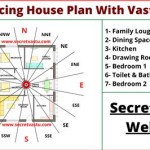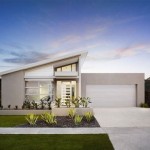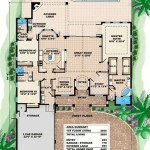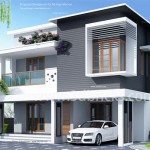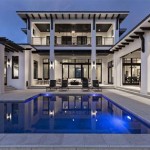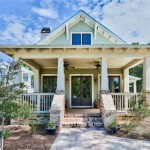Prow Front Style House Plans: Design, Features, and Considerations
Prow front house plans, characterized by a distinctive elevated front facade that slopes dramatically upwards, are architectural designs that offer a unique aesthetic and functional appeal. These plans are often associated with mountain homes, lakefront properties, and scenic landscapes, capitalizing on panoramic views and natural light penetration. Understanding the defining features, advantages, and potential drawbacks of prow front designs is crucial for homeowners considering this style.
Defining Characteristics of Prow Front House Plans
The defining feature of a prow front house is its angled or triangular front facade. This projection resembles the prow of a ship, hence the name. This design typically incorporates large expanses of glass, maximizing the view and allowing natural light to flood the interior spaces. Structurally, the prow is often supported by a combination of load-bearing walls and strategically placed posts or beams. The prow can be a single, continuous slope or can be tiered with multiple angled surfaces. The angle of the prow significantly impacts the interior space and the overall aesthetic of the house. A steeper angle creates a more dramatic effect, while a shallower angle provides a more subtle appearance.
Prow front homes frequently incorporate open floor plans. The large windows of the prow facilitate a seamless transition between indoor and outdoor spaces. The open design often includes a great room or living area located directly behind the prow, taking full advantage of the view. The kitchen and dining areas are often integrated into this open space, creating a cohesive and social environment. The orientation of the prow is typically planned to optimize exposure to sunlight and prevailing winds. This is a key consideration in energy efficiency and passive solar heating.
The exterior materials used in prow front homes often complement the natural surroundings. Wood siding, stone accents, and metal roofing are common choices. These materials add a rustic or contemporary feel, blending the house with the landscape. The roof design is another defining element. Gable roofs, shed roofs, and combination rooflines are frequently used in conjunction with the prow front. The roof design can either accentuate the prow or create a contrasting visual element. The placement of windows and doors is carefully considered to balance natural light, ventilation, and privacy. Large windows are often placed on the prow to maximize the view, while smaller windows or skylights might be used in other areas of the house to control light and heat gain.
The style of a prow front home often extends beyond the functional aspects into the realm of visual art. The dramatic angles and expansive windows produce a visually striking construction, making it a focal point that demands attention. The exterior lighting design can further enhance the dramatic effect of the prow at night. Strategic placement of spotlights and floodlights can accentuate the architectural features and create a welcoming ambiance.
Advantages of Choosing a Prow Front Design
The primary advantage of a prow front house is its maximization of views. The large windows and elevated perspective offer unparalleled vistas of the surrounding landscape. This is particularly appealing for properties with scenic surroundings, such as mountains, lakes, or forests. The natural light penetration is another significant benefit. The expansive windows allow ample sunlight to flood the interior spaces, creating a bright and airy atmosphere. This can reduce the need for artificial lighting and contribute to energy savings.
Prow front homes often have a unique and eye-catching aesthetic. The dramatic architecture makes a strong statement and sets the house apart from more traditional designs. This can be a significant advantage for homeowners seeking a distinctive and modern look. Open floor plans are another common feature of prow front designs. These plans promote social interaction and create a sense of spaciousness. The open layout is ideal for families and individuals who enjoy entertaining guests. The design can be adapted to suit various lifestyles and preferences. The size and layout can be customized to meet the specific needs of the homeowner. The materials and finishes can be chosen to reflect individual style and taste.
The improved thermal performance is potentially another advantage. When designed and constructed properly, the prow front can enhance the house's ability to capture solar heat during the winter months. The angle of the prow can be optimized to maximize solar gain. The strategic placement of overhangs and shading devices can help to control the amount of sunlight entering the house during the summer months, reducing cooling costs. The structural integrity and durability of prow front homes can be enhanced by using high-quality materials and construction techniques. Proper insulation and weatherproofing are essential to prevent air leaks and moisture damage.
The resale value of a well-designed prow front home can be higher than that of a more conventional house. The unique architecture and desirable features can attract a wider range of buyers. Proximity to natural amenities, such as lakes, mountains, or forests, can further enhance the resale value. A prow front home can offer a sense of connection to nature. The views and natural light create a more immersive and relaxing living environment. This is particularly appealing for homeowners who value tranquility and serenity.
Construction Considerations and Potential Drawbacks
One of the primary construction challenges associated with prow front homes is the complex structural engineering required. The angled facade creates unique load-bearing requirements that must be carefully addressed. This can increase the cost of construction compared to simpler designs. The cost of windows and glazing is another significant consideration. The large windows required for the prow front can be expensive, especially if energy-efficient or specialty glass is used. The installation of these windows can also be challenging and require specialized expertise.
Maintaining proper insulation and weatherproofing can be difficult in prow front homes. The angled surfaces and large windows can be prone to air leaks and moisture penetration. This can lead to higher energy bills and potential structural damage. The design can be less energy efficient than traditional designs if not properly planned and executed. The large windows can result in excessive heat gain during the summer months and heat loss during the winter months. This can increase the need for air conditioning and heating, leading to higher energy consumption.
Privacy can be a concern in prow front homes, particularly if the house is located in a densely populated area. The large windows can make it difficult to maintain privacy from neighbors or passersby. This can be mitigated by using window coverings, strategically placed landscaping, or tinted glass. The interior space might be less functional than in traditional designs. The angled walls of the prow can create awkwardly shaped rooms or limited wall space for furniture placement. Careful planning and design are essential to maximize the usability of the interior space. The cost of custom design work and specialized construction can be higher for prow front homes. The unique architectural features often require custom design solutions and specialized construction techniques, which can increase the overall cost of the project.
Obtaining building permits can be more challenging for prow front homes. The complex design and unique structural requirements may require additional scrutiny from local building officials. This can delay the construction process and increase the cost of obtaining permits. The potential for glare from the large windows can be a concern, especially during certain times of the day. This can be mitigated by using window coverings, tinted glass, or strategically placed landscaping. The susceptibility to wind damage is another potential drawback. The large, angled surfaces of the prow can be more vulnerable to wind damage than traditional structures. Proper engineering and construction techniques are essential to ensure the structural integrity of the house in high-wind areas.
Resale challenges can arise if the unique design does not appeal to a wide range of buyers. While some buyers may be drawn to the distinctive architecture, others may prefer a more traditional style. This can limit the pool of potential buyers and potentially affect the resale value. Maintenance requirements for the exterior surfaces can be higher than for traditional designs. The large, angled surfaces can be more difficult to clean and maintain. Regular painting, staining, or sealing may be required to protect the exterior surfaces from the elements.
Key Design Elements to Consider
Optimizing the view and light involves careful consideration of the house's orientation and the placement of windows. Orienting the prow towards the most scenic view is crucial. Using high-performance glass can minimize heat gain and loss while maximizing natural light penetration. Balancing privacy and openness is another important design element. Strategically placing windows and using window coverings can help to maintain privacy without sacrificing the view or natural light. Integrating the house with the surrounding landscape is essential for creating a cohesive and harmonious design. Using natural materials, such as wood and stone, can help to blend the house with the environment. Landscaping can also be used to enhance the visual appeal of the house and provide privacy.
Ensuring energy efficiency requires careful attention to insulation, weatherproofing, and window design. Using high-quality insulation and weatherproofing materials can minimize air leaks and heat loss. Choosing energy-efficient windows with low-E coatings can further reduce energy consumption. Addressing structural integrity is paramount for the safety and longevity of the house. Working with a qualified structural engineer is essential to ensure that the prow is properly supported and able to withstand wind and snow loads. The style integration with the interior design plays a crucial role. The interior design should complement the architectural style of the house. Using natural materials, open floor plans, and modern furnishings can create a cohesive and stylish living space.
Addressing accessibility requires careful planning to ensure that the house is accessible to people of all abilities. Incorporating ramps, wider doorways, and accessible bathrooms can make the house more inclusive and comfortable for everyone. Minimizing maintenance requirements is another important consideration. Choosing durable and low-maintenance materials can reduce the amount of time and money spent on upkeep. Designing for weather conditions specific to the location is important. Considerations include wind resistance, snow load capacity, and protection from excessive sun exposure. Selecting the right materials and structural design to withstand location-specific weather events ensures the long-term integrity of the home.

Prow Floor Plans Colorado Building Systems

Prow Floor Plans Colorado Building Systems

Tupper Lake Prow Woodhouse The Timber Frame Company

Prow Linwood Homes

Golden Eagle Log And Timber Homes Plans Plan Details Custom Prow Lofted

Plan 99946 Contemporary Cabin Home With Prow Window Wall

2 Bed Craftsman Home Plan With Prow Shaped Vaulted Great Room 23025jd Architectural Designs House Plans

Ponderosa E Prow Front Design Liscott Custom Homes Ltd

3 Bedroom 2 Story Modern Beach Style House Plan 1878

Prow Front Chalet Rustic Exterior House Design

